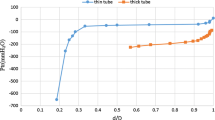Abstract
A one-dimensional theory of steady flow through a tube with non-uniform elastic properties is developed. The importance of the speed of pressure waves on the tube (the sonic speed) is pointed out, and the characteristics and stability of subsonic and supersonic flow are examined. Subsonic flow is always stable. Stable supersonic flow is sometimes possible, but latent instability may lead to a localized transition (a hydraulic jump) to subsonic flow, associated with energy dissipation through turbulence.
Supersonic flow can develop only by a smooth transition through the sonic speed at certain points called sonic elastic constrictions, each of which controls the flow pattern in the upstream subsonic and downstream supersonic regions. Between two successive sonic constrictions a hydraulic jump occurs, the position of which is controlled by the two constrictions. These phenomena are illustrated by photographs of a model system.
The shape of the typical male urethra during micturition suggests that there are two sonic elastic constrictions, one in the high-pressure region near the junction of the prostatic and membranous parts of the urethra, and the other near the external meatus. The first controls the flow rate, and the second the characteristics of the stream beyond the meatus. The properties of the cavernous urethra, lying between the two constrictions, normally have no effect on the flow rate nor on the urine stream. This conclusion is supported by a simple experimental observation.
Sommaire
On développe une théorie uni-dimensionelle d'un écoulement constant à travers un tube avec propriétés élastiques non-uniformes. On souligne l'importance de la vitesse des ondes de pression sur le tube (la vitesse sonique) et l'on examine les caractéristiques et la stabilité d'écoulements subsoniques et supersoniques. L'écoulement subsonique est toujours stable. Un écoulement supersonique stable est quelquefois possible mais une instabilité latente peut mener à une transition localisée (un saut hydraulique) à un écoulement subsonique, associé à une dissipation d'énergie par la turbulence.
L'écoulement supersonique ne peut se développer que par une transition douce par la vitesse sonique à certains points appelés constrictions élastiques soniques, dont chacune contrôle le mode d'écoulement dans les régions du courant d'amont subsonique et du courant aval supersonique. Entre deux constrictions soniques successives, un saut hydraulique a lieu dont la position est contrôlée par les deux constrictions. Ces phénomènes sont illustrés par des photographies d'un système modèle.
La forme de l'urèthre mâle typique au cours de la micturation suggère qu'il existe deux constrictions élastiques soniques, l'une dans la région haute pression près de la jonction des parties membraneuses et prostatiques de l'urèthre, l'autre près du meatus externe. La première contrôle le débit, la deuxième les caractéristiques du faisceau au-delà du meatus. Les propriétés de l'urèthre caverneuse entre les deux constrictions, n'ont généralement aucun effet sur le débit ou le faisceau de l'urine. Cette conclusion est supportée par une simple observation expérimentale.
Zusammenfassung
Es wird eine eindimensionale Theorie der Strombeständigkeit durch eine Röhre mit ungleichförmigen elastischen Eigenschaften entwickelt. Es wird auf die Wichtigkeit der Druckwellengeschwindigkeit auf die Röhre (die Schallgeschwindigkeit) hingewiesen, und es werden die Eigenschaften und die Stabilität von Unterschall- und Überschallstrom untersucht. Unterschallstrom ist immer beständig. Beständiger Überschallstrom ist manchmal möglich, aber latente Unbeständigkeit kann zufeinem örtlich begrenzten Übergang (einem hydraulischen Sprung) auf Unterschallstrom im Zusammenhang mit Energieverbrauch durch Turbulenz führen.
Überschallstrom kann sich nur in einem allmählichen Übergang durch die Schallgeschwindigkeit an bestimmten Punkten entwickeln, welche elastische Schallverengungen genannt werden, von denen jede die Stromstruktur in der Unterschallregion stromaufwärts und der Überschallregion stromabwärts regelt. Zwischen zwei aufeinanderfolgenden Schallverengungen erfolgt ein hydraulischer Sprung, dessen Lage durch die zwei Verengungen bestimmt ist. Diese Phänomene werden an Hand von Photographien eines Modellsystems illustriert.
Die Form der typischen männlichen Harnröhre während Harnens lässt darauf schliessen, dass es zwei Schallverengungen gibt, die eine in der Hochdruckgegend nahe dem Verbindungspunkt der Prostatateile und der membranlösen Teile der Harnröhre, und die andere nahe dem äusseren Meatus. Die erste regelt die Strömungsgeschwindigkeit, und die zweite die Eigenschaften des Stroms über den Meatus hinaus. Die Eigenschaften der kavernösen Harnröhre, die zwischen den zwei Verengungen liegt, haben im allgemeinen keinen Einfluss auf die Strömungsgeschwindigkeit oder auf den Urinstrom. Dieser Schluss wird in einer einfachen experimentellen Beobachtung bestätigt.
Similar content being viewed by others
Abbreviations
- c :
-
speed of waves on elastic-walled tube, cm s−1
- d/dr :
-
derivative with respect tor, cm−1
- d/dx :
-
total derivative with respect tox, cm−1
- (∂/∂X) r :
-
partial derivative with respect tox at constantr, cm−1
- g :
-
gravitational acceleration, cm s−2
- h :
-
vertical distance below a given point, cm
- P :
-
pressure within elastic-walled tube, dyn cm−2
- P 0 :
-
local stagnation pressure (total head), dyn cm−2
- Q :
-
volume flow rate, cm3 s−1
- r :
-
radius of elastic-walled tube, cm
- v :
-
fluid speed, cm s−1
- x :
-
distance measured in direction of flow, cm
- ρ:
-
fluid density, g cm−3
References
Griffiths, D. J. (1969a) Urethral elasticity and micturition hydrodynamics in females.Med. biol. Engng 7, 201–215.
Lamb SirH. (1932)Hydrodynamics, p. 280. Dover, New York.
Prandtl, L. andTietjens, O. G. (1934)Applied Hydro and Aeromechanics, p. 68. McGraw-Hill, New York.
Author information
Authors and Affiliations
Rights and permissions
About this article
Cite this article
Griffiths, D.J. Hydrodynamics of male micturition—I Theory of steady flow through elastic-walled tubes. Med. & biol. Engng. 9, 581–588 (1971). https://doi.org/10.1007/BF02474637
Received:
Issue Date:
DOI: https://doi.org/10.1007/BF02474637




